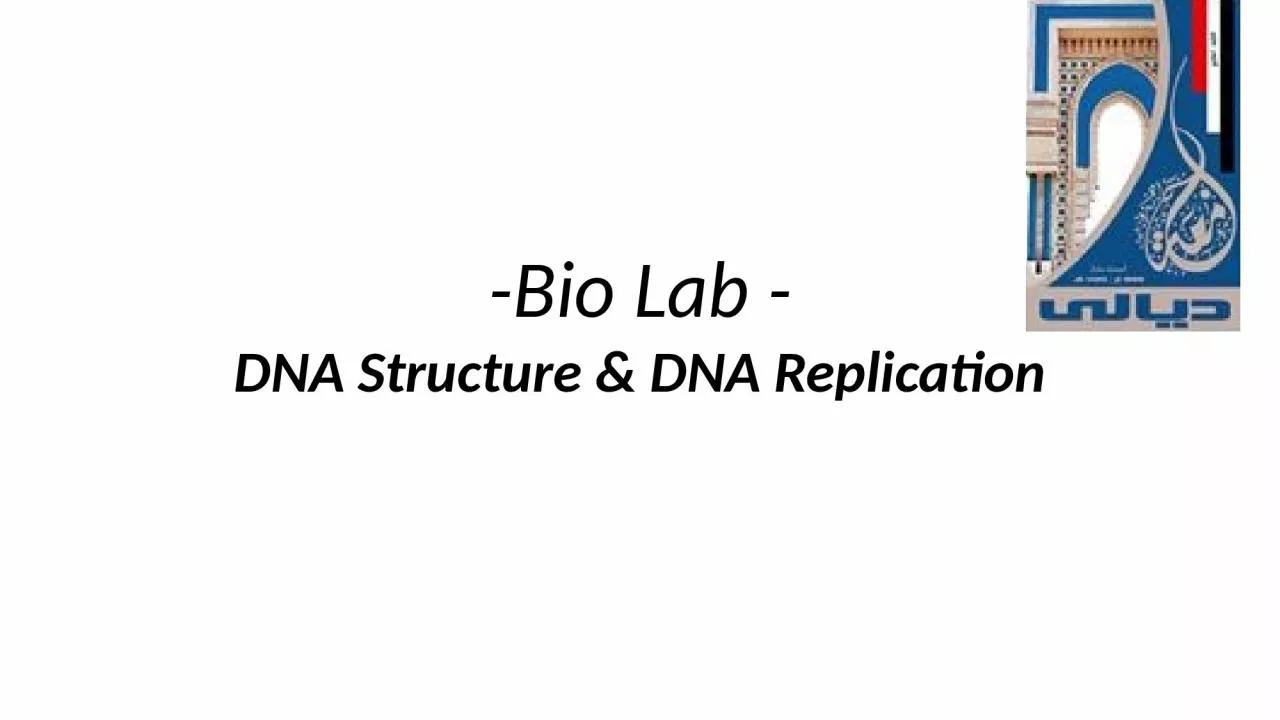

What is DNA DNA is a Nucleic Acid in the nucleus Polymer of Nucleotides Each nucleotide consists of Deoxy ribose 5carbon sugar Phosphate group a nitrogencontaining base Four bases ID: 1036592
Download Presentation The PPT/PDF document "-Bio Lab - DNA Structure & DNA Repli..." is the property of its rightful owner. Permission is granted to download and print the materials on this web site for personal, non-commercial use only, and to display it on your personal computer provided you do not modify the materials and that you retain all copyright notices contained in the materials. By downloading content from our website, you accept the terms of this agreement.
1. -Bio Lab -DNA Structure & DNA Replication
2. What is DNA?DNA is a Nucleic Acid in the nucleusPolymer of NucleotidesEach nucleotide consists ofDeoxy ribose (5-carbon sugar) Phosphate groupa nitrogen-containing baseFour bases(Purines)Adenine, Guanine and (Pyrimidines) Thymine, Cytosine
3. Nucleotide Structure
4. The scientists discovered that DNA was some sort of helix like Watson-Crick Model showed that DNA consists of two nucleotide strands: Double HelixStrands run in opposite directions - AntiparallelStrands are held together by hydrogen bonds between basesA binds with T and C with GThe sides of the ladder are a sugar-phosphate backbone, while the “rungs” of the ladder are the bases.
5.
6. Base-pairing ruleThe four bases of DNA are:Adenine (A) Guanine (G) Thymine (T) Cytosine (C)Adenine always hydrogen bonds with Thymine (A-T)Guanine always hydrogen bonds with Cytosine (G-C)These bonding patterns are called base pairings (bp)
7. DNA ReplicationBefore mitosis and meiosis, all of the DNA in the cell must be copied or replicated How does this happen?
8. The mechanism by which DNA is replicated is considered semi-conservativeSemi-conservative replication: Half of the original parent DNA molecule is conserved in each of the daughter molecules. This allows for the parent DNA to serve as a template for generating the daughter DNA moleculesHalf of the replicated DNA strand is “old” and the other half is “new”
9. newnewoldold
10. DNA is synthesized 5’ to 3’Energy for synthesis comes from the removal of the two phosphates of the in coming nucleotide.Because DNA is antiparallel, synthesis occurs in opposite directions.
11.
12. Features of replicationSemi-conservative processInitiation at specific origins Replication movement usually bidirectionalStrands elongated 5’ to 3’Semi-discontinuous
13. Basic requirements for replication1- Template (both strand of parental DNA)2- Nucleotides (dATP, dTTP, dGTP, dCTP)3- Enzymes: DNA polymerase, Helicase, Primase and Ligase.4- RNA primer5- Proteins: Single strand binding proteins (SSB).
14. Proofreading – error control system
15. The replication is from 5’ to 3’ direction of the two strands, one strand is synthesized continuously (5’ to 3’) in the direction of movement of the replication fork called “leading strand”; while the other strand is synthesized discontinuously away from the movement of the replication fork in short fragments called “Okazaki fragments” and its strand called the “lagging strand”
16.
17. 17DNA Replication steps:The chromosome of a prokaryote is a circular molecule of DNA.Replication begins at one origin of replication and proceeds in both directions around the chromosome.There are three steps includes:Initiation: Replication begins at an origin.Elongation: New strands of DNA are synthesized by DNA polymerase.Termination: Replication is terminated.
18.